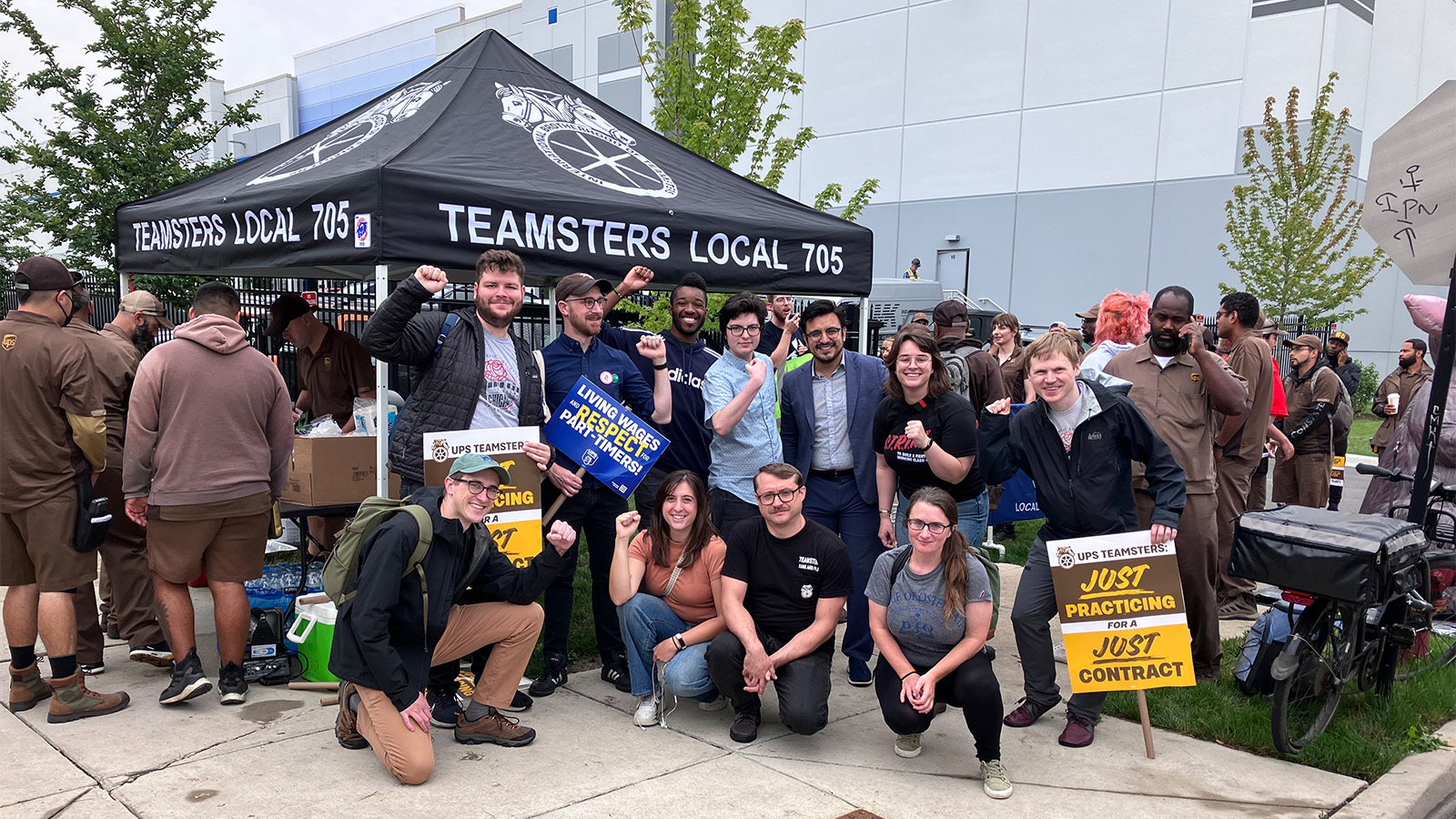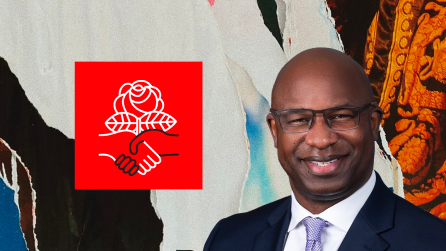As DSA Convention season descends on us, a familiar debate from previous conventions has re-emerged. This time it comes in the form of an amendment from the new slate Groundwork to the National Labor Commission’s consensus resolution on DSA’s labor work. Groundwork’s “We Are Workers” amendment would, among other things, strip out language from the consensus resolution that explicitly rejects a strategy of prioritizing relationships with union establishment in favor of a strategy of prioritizing building relationships with the rank and file. The amendment also advocated for deprioritizing working with Labor Notes (which shares DSA’s support for a rank and file orientation to the labor movement). Criticism came quickly, with longtime DSA labor organizers noting that our Rank and File Strategy (RFS) adopted in 2019 has gotten us quite far in our labor work. Supporters of the amendment responded, some criticizing DSA’s labor strategy as preventing them from working with union leadership on legislative projects and others arguing that this amendment leaves the RFS, which they love, intact but lets people do other things as well.
Leave aside for the moment that the amendment’s supporters rely almost entirely on examples of working with union leadership where the leadership and membership are not in dispute (a distinction worthy of its own separate analysis) and that our already-adopted Rank and File Strategy has been no barrier to working with union leadership on issues where membership and leadership are aligned. Also leave aside the question of what the distinction is between a union’s leadership and the union establishment (another separate piece). I want to focus on what it can and does look like to work with union leadership. There’s nothing wrong with building relationships and working with union leadership, as many of the staunchest supporters of the RFS in DSA regularly do in our labor work. But what kind of relationships are we building? What kind of relationships are possible?

We can classify cooperative relationships between DSA and a union into three types: Transactional, Top-Down Relational, and Bottom-up Relational. This, of course, leaves aside more frosty or openly antagonistic relationships (virtually all of which, it’s worth noting, are more a consequence of distrustful staff and officers than membership sentiment). Let’s take each of these three categories of positive relationships with unions in turn.
1. Transactional
This is probably the most common type of relationship with a union that we see in our electoral or legislative campaign work. This is a relationship where a union’s leadership, usually its political director and top officers, see value for themselves and their union in working with DSA on something. It may be that what DSA wants to do benefits them directly, as in legislative campaigns that involve increasing funding for their members’ jobs and departments. Sometimes the transaction is slightly more long term, and the leadership works with us because they’ll want to have a good political relationship down the line for something they want, as is common in our electoral work seeking endorsements.
This kind of relationship can net significant benefits in the immediate term, but they tend to be shallow, with the relationship existing entirely between some representative of DSA and some representative of the union. This means that DSA becomes dependent on individual members holding the relationship with the union (or just its political director), putting a long-term burden on them that can quickly lead to burnout and a loss of that working relationship. While you can try to bring others into those meetings and expand the relationship by ones and twos, that is not sustainable in a mass organization.
Political directors are often the staffers least tied to the mission and membership of their unions, usually jumping between union world and the world of electoral politics. Such a leadership is not going to move the union to do anything they aren’t inclined to do, absent DSA being able to give them something. And fundamentally, this kind of relationship reinforces a top-down, transactional approach within that union in how it relates to the broader political scene. These kinds of relationships cannot possibly transform that union or the labor movement. Instead they reinforce a status quo that has not, will not, move us closer to our goals as socialists.
2. Top Down Relational
This second category goes beyond the transaction of the first category. The union’s leadership are excited or impressed by DSA’s work and want to build with us long term, becoming recurring partners with us on our work. Maybe those union leaders see themselves as socialists. They may even be DSA members. The continued relationship is an end in itself, unlike the transactional relationship. They may send speakers to our events, buy ads and tables at our fundraisers, even endorse our legislative campaigns and candidates. This is often a result of DSA doing strike support work that demonstrates a deep political commitment, rather than a mere transactional commitment, to working with them, as well as shared ideals and goals.
This is a big step up from a transactional relationship, but it is still limited in many ways. As wonderful as a particular leader may be, these kinds of relationships are still simply person to person, rather than membership-to-membership or organization-to-organization, and they run into the same bottlenecks discussed above.
In addition, there is only so far a leader can take their union themselves. Even a dedicated socialist in a union presidency is going to be limited by conditions in their union and by the institutional forces of being an officer, with legal and fiduciary duties to the union and other conservatizing influences. Officers in such positions will therefore end up feeling even more limited than they may actually be. They’d love to go further in their support for our work, but their position simply won’t let them go that far.
Further, even if they do push the limits of the bounds of their office, they’re ultimately answerable to their membership. Unlike virtually every other part of US society, unions are all democracies, at least nominally and structurally, and a union leader who strays too far from where the membership is can quite easily be disciplined in the next election. A relationship with the leaders, therefore, can only ever get you so far.
3. Bottom Up Relational
In this final category the relationship between DSA and the union is more ideologically driven than by transaction and rooted not in the whims of a particular leader, but rather by a core of militant rank and filers. In this situation, union members who are leaders on the shop floor, and who are ideally themselves socialists and DSA members, are continually finding ways for their union to work closely with DSA on shared work, such as a contract fight or a legislative campaign. Perhaps they, carrying considerably more weight with union leadership than some non-member from DSA would have, have convinced their leadership that this collaboration makes sense. Perhaps they have not yet gotten leadership on board but are bringing their fellow union members into the shared DSA work in a way that makes it harder and harder for leadership to say no. Ultimately, leadership either stands aside or actively builds a relationship with DSA, based not on quid pro quo nor on their particular political inclinations, but on a firm foundation of a militant base of member-organizers excited to bring their union and the socialist movement closer together.
The most obvious benefit this kind of relationship has over the other sorts is its durability. It is much harder to get rid of a group of shop floor militants than it is to get rid of a staffer or even an officer. In addition, should leadership change hands to someone more hostile to DSA, the shop floor militants can continue their organizing, continue bringing coworkers into DSA work and continue organizing around DSA work in their union, until either the new leadership relents, embraces DSA, or is replaced yet again.
More importantly, though, this kind of relationship leads to more genuine collaboration and cross-membership growth. While it’s great to have a union president decide to join DSA, we’re a mass organization; it is far more powerful to have a crew of shop stewards, dozens of shop floor leaders, hundreds of rank and file members join DSA. That is far more likely to happen if we’re organizing with them, rather than prioritizing leadership and hoping for trickle-down recruitment. A relationship with leadership that comes from their own membership ensures that leadership knows how serious we are, that our organizing prowess is for real, and that we should be treated with the respect of a group that knows how to bring a crowd to a fight.
What are DSA’s Relationships Like Now, and Where Do We Go From Here?
With this framework in place, what do our current relationships with union leadership look like? I think it’s fair to say that in many places, most of our relationships are in the first category, with a hope that continued work will get us to the second. Few of our relationships fit into that third category, but those have been some of the most rewarding. Far and away, the best example of this kind of relationship has been our relationship nationally — and in some places locally — with the Teamsters. There, we have dozens of DSA members who are shop floor militants, many of whom are long-term respected leaders who, when they speak, command the attention of their fellow members and their leadership. Those DSA shop floor leaders have successfully advocated for DSA to be brought in as a leading force in the UPS Contract coalition, buoyed by the excellent work the NLC and DSA chapters across the country have done with rank and filers to organize the broader working class around this fight. In the process, we have brought even more shop floor leaders who had not previously considered themselves socialists into DSA, growing our core of rank and file militants and in so doing increasing the seriousness with which the union’s leadership treats us.
This should be the model for our relationships with union leadership; treating it not as a priority, not as the focus of our strategy, but as the result of prioritizing relationships with the rank and file, and in so doing have sturdier, more powerful relationships with the labor movement as a whole. This is crucial; the ultimate goal of DSA’s labor work is not to have a socialist movement that works well with the labor movement, but a socialist movement that has merged with the labor movement. We need more union members to become organized socialists, and more organized socialists to become union members, so that we can eventually have the organized base to bring these entities together into a force that can accomplish our goals and create the world we know we need.
Our greatest weapon in that pursuit is the collective withholding of our labor from capital. We can’t get there through relationships with labor leaders. A union president can do a lot of things that can be useful to us, but they can’t withhold the labor of their members by themselves. The president can say “we’re on strike” until they’re blue in the face, but if the members aren’t onboard, it’s not going to happen. The membership are the beating heart of every union. When that heart doesn’t beat, nothing will happen, no matter how many socialist or socialist-friendly leaders you have. This is why, strategically speaking, if we want to build the labor movement we need to win socialism, a strategy that prioritizes building relationships with union leadership simply will not get us there, and must be rejected.
This is not to say that we should never work with and build relationships with union leadership, as so much of our existing work conducted under the Rank and File Strategy has shown. We do it tactically for a variety of reasons. But strategically, that cannot and should not be the priority. When push comes to shove, we know that the power lies with the rank and file, because while the rank and file can change their leadership, the leadership can’t change their rank and file. Any amendment to our labor strategy that loses sight of that will weaken DSA, harm our labor work, and distract from our goal of building a militant, democratic, socialist labor movement.




